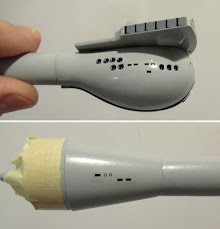Here's one I assembled in 2012, the Wolverine Phoenix.
It's a clone of the big Estes Phoenix kit, #1380.
There was a glitch in the pre-production kit I received.
The model is made up of two BT-80 body tubes, the lower tube should be 14" long, the upper tube, 7.6" long. Both tube lengths are joined by a coupler.
In my "kit" the lower body tube was sent at its original length of 18". I assumed the tubes were the correct length and assembly followed.
Having never built a Phoenix rocket before, it didn't think anything was amiss until I went to apply the decals. The open mid section ended up about 4" too long!
While building, I also drew up the kit instructions for Uncle Mike's Rocket Shack/Wolverine Rocketry.
Here's a link to the first build from finish to start:
CLICK HERE
This project is to cut out the extra four inches as cleanly as I can.
The scrap tube will have to be peeled off the coupler. Cleaned up then rejoined (hopefully) at the right length. I might lose the upper launch lug. I can home print and replace the small black decals in the middle.
This has bugged me for years! The model has never been flown.





















































